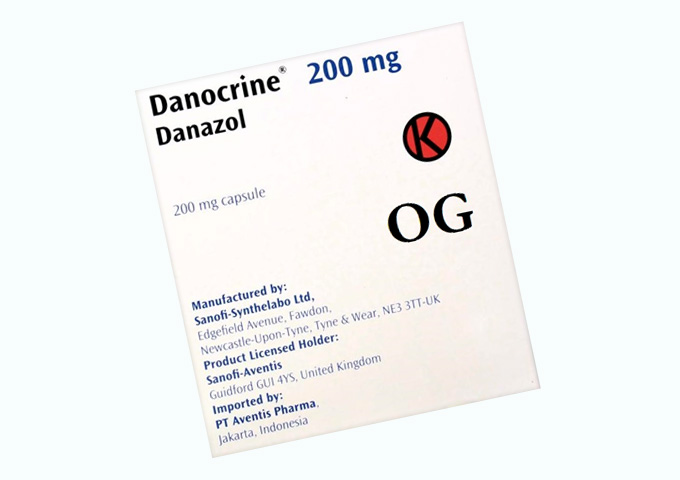Danocrine (Danazol)
Danocrine is the brand name for the drug danazol, which is a synthetic steroid derived from ethisterone. It is primarily used to treat certain medical conditions related to the female reproductive system, such as endometriosis, fibrocystic breast disease, and hereditary angioedema.
Uses
As mentioned earlier, Danocrine is primarily used to treat the following medical conditions:
- Endometriosis: Medicine is used to manage endometriosis, a condition in which tissue similar to the lining of the uterus (endometrium) grows outside the uterus. This can cause pelvic pain, painful menstrual periods, and fertility issues. Danazol helps by suppressing ovulation and reducing the growth of endometrial tissue.
- Fibrocystic Breast Disease: Also known as fibrocystic changes or benign breast disease, this condition causes noncancerous lumps and cysts in the breasts, leading to tenderness and discomfort. Danocrine may be prescribed to alleviate these symptoms.
- Hereditary Angioedema: Medicine is used to prevent attacks of hereditary angioedema, a rare genetic condition that causes recurrent episodes of swelling, typically affecting the face, throat, and extremities. By reducing the levels of certain proteins in the blood, Danocrine helps to decrease the frequency and severity of these attacks.
It's important to note that Danocrine is not a first-line treatment for these conditions and is typically reserved for cases where other therapies have not been effective or are not suitable.

Dosage
The dosage of Danocrine can vary depending on the specific medical condition being treated and individual patient factors. The information provided here is a general guideline, but individual dosing may differ.
For endometriosis and fibrocystic breast disease, the typical recommended dosage of Danocrine is:
- Initial Dosage: 200 to 800 milligrams per day, divided into two equal doses.
- Maintenance Dosage: After improvement is noted, the dosage is often reduced to the lowest effective dose to maintain symptom relief.
For hereditary angioedema, the usual dosage is:
- Prevention of Attacks: 200 to 600 milligrams per day, divided into two or three doses.
Dosage adjustments and duration of treatment will be based on the individual patient's response to the medication, the severity of the condition, and any side effects that may occur.
Danazol is typically taken orally with food or after meals to reduce stomach upset. It's essential to take the medication at the same time each day to maintain consistent blood levels.
Since Danocrine can interact with other medications and may not be suitable for individuals with certain medical conditions.
Overdose
An overdose of Danocrine can be potentially serious and may require immediate medical attention. If you suspect that you or someone else has taken more than the prescribed dose of drug, contact emergency medical services or your local poison control center right away.
Symptoms of Danocrine overdose may include:
- Nausea and vomiting: Excessive intake of Danocrine can lead to severe gastrointestinal symptoms like nausea and vomiting.
- Abdominal pain: Intense abdominal pain or discomfort may occur as a result of an overdose.
- Headache: Severe headaches may be experienced in cases of overdose.
- Flushing: The skin may become flushed or reddened.
- Edema: Swelling of the feet, hands, or face can occur due to fluid retention.
- Muscle cramps: Painful muscle cramps may be present.
- Androgenic effects: Overdose of Danocrine can cause increased androgenic side effects, such as acne, oily skin, and increased body hair growth.
- Menstrual irregularities: For women, overdose may lead to irregular menstrual periods or other menstrual disturbances.
Treatment for Danocrine overdose is generally supportive and may include:
- Gastric lavage: If the overdose was recent, you may perform gastric lavage (stomach pumping) to remove the unabsorbed drug from the stomach.
- Activated charcoal: Administration of activated charcoal can help reduce absorption of the drug from the gastrointestinal tract.
- Monitoring and supportive care: Vital signs, such as blood pressure and heart rate, will be monitored. Supportive care, such as intravenous fluids and medications to manage symptoms, may be provided.
Precautions
When using Danocrine, it is essential to be aware of the following precautions to ensure safe and effective treatment:
- Pregnancy and Breastfeeding: Danocrine should not be used during pregnancy, as it can harm the developing fetus.
- Liver Function: Medicine may affect liver function. Regular liver function tests should be performed during treatment to monitor for any signs of liver problems.
- High Cholesterol: Medicine can increase cholesterol levels. Regular monitoring of cholesterol levels and appropriate management may be necessary during treatment.
- Androgenic Effects: Danocrine has mild androgenic properties and may cause side effects such as acne, oily skin, and increased body hair growth.
- Blood Sugar Levels: Remedy can affect blood sugar levels and may lead to insulin resistance. If you have diabetes or are at risk for diabetes, monitor your blood sugar levels closely.
- Interactions with Other Medications: Tablets may interact with certain medications, including anticoagulants, cyclosporine, and certain oral hypoglycemic agents.
- Hereditary Angioedema Attacks: Danocrine is used to prevent attacks of hereditary angioedema.
- Monitoring: Regular monitoring of your condition and response to treatment is crucial.
- Children and Elderly: Danocrine is not typically used in children and elderly populations due to safety concerns and lack of sufficient data for these age groups.
Side Effects
Danocrine may cause various side effects, ranging from mild to severe. Not everyone will experience these side effects, and some individuals may have a higher likelihood of developing certain reactions. Common side effects may include:
- Androgenic Effects: Danocrine has mild androgenic properties and can cause symptoms such as acne, oily skin, and increased body hair growth.
- Weight Gain: Some individuals may experience weight gain while taking Danocrine.
- Hot Flashes: Hot flashes, a sudden feeling of warmth or heat, may occur.
- Irregular Menstrual Periods: Women taking Danocrine may experience changes in their menstrual cycle, including irregular periods.
- Decreased Breast Size: Pharmaceutical product may cause a reduction in breast size.
- Headache: Headaches are a common side effect reported by some individuals.
- Nervousness or Mood Changes: Some people may experience nervousness or mood changes while using Danocrine.
- Decreased Breast Milk Production: For breastfeeding mothers, Danocrine may decrease breast milk production.
- Liver Problems: Danocrine can affect liver function, and in some cases, it may cause liver problems. Regular liver function tests are typically recommended during treatment.
- High Cholesterol Levels: Medicament can increase cholesterol levels in the blood.
- Edema: Swelling of the feet, ankles, or hands may occur due to fluid retention.
- Changes in Voice: Some individuals may notice changes in their voice, such as hoarseness.
- Insomnia: Danocrine may cause difficulty falling asleep or staying asleep.
- Gastrointestinal Disturbances: Nausea, vomiting, and abdominal pain are possible side effects.
- Allergic Reactions: While rare, some individuals may experience allergic reactions to Danocrine. Seek medical attention immediately if you notice signs of an allergic reaction, such as rash, itching, swelling, severe dizziness, or difficulty breathing.
It's important to note that this list may not be exhaustive, and other side effects may occur. Additionally, individual responses to medications can vary, so not everyone will experience the same side effects.
Storage
When storing Danocrine or any medication, it's essential to follow specific guidelines to maintain its effectiveness and safety. Here are some general storage recommendations:
- Temperature: Store pills at room temperature, typically between 20°C to 25°C (68°F to 77°F). Avoid exposing the medication to extreme temperatures, such as direct sunlight, heat, or freezing conditions.
- Moisture: Keep Danocrine in a dry place. Moisture can degrade the medication and reduce its potency.
- Original Packaging: Store the medication in its original packaging or container. This helps protect it from light, moisture, and contamination.
- Keep Away from Children and Pets: Store tablets in a secure location, out of the reach of children and pets. Accidental ingestion of medication can be harmful.
- Out of Reach of Unauthorized Users: Ensure that Danocrine is not accessible to individuals who are not authorized to use the medication.
- Avoid Bathroom and Kitchen Storage: Refrain from keeping medications in the bathroom or kitchen, as these areas can be prone to temperature fluctuations and moisture.
- Properly Close Containers: Always close the medication container tightly after use to prevent air and moisture from entering.
- Discard Expired Medication: Check the expiration date on the packaging, and do not use Danocrine after it has expired. Expired medications may be less effective or unsafe to use.
- Disposal: If you have any unused or expired Danocrine, dispose of it properly according to local guidelines or consult a pharmacist for proper disposal instructions.
Remember that proper storage not only helps maintain the effectiveness of the medication but also ensures the safety of everyone in your household.
